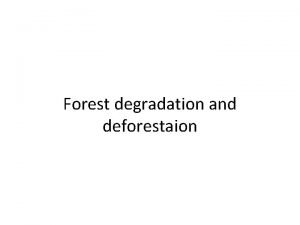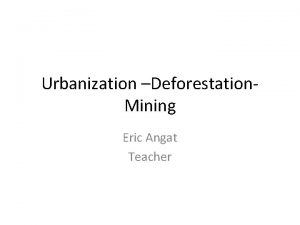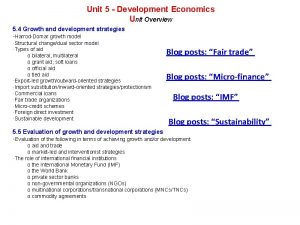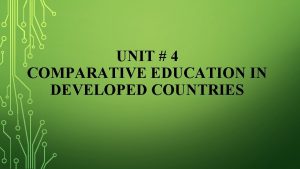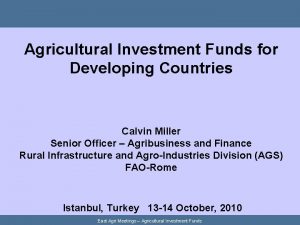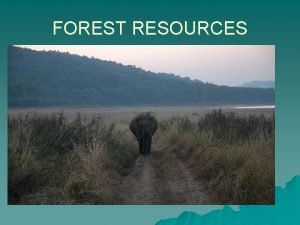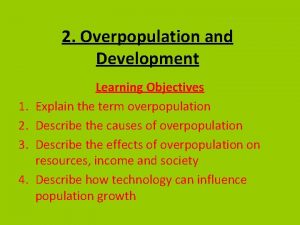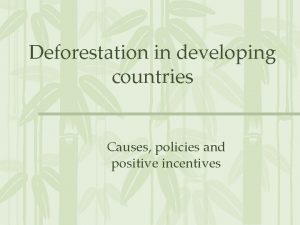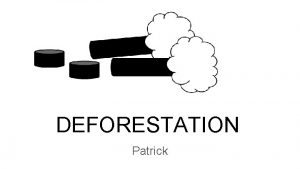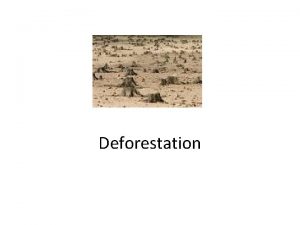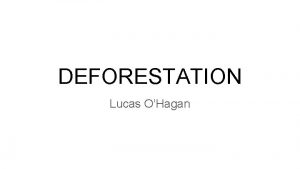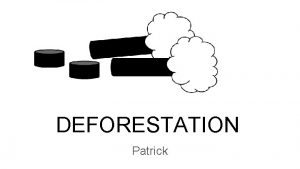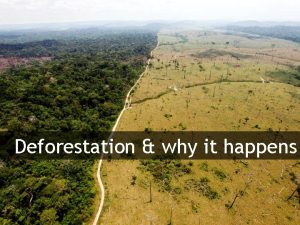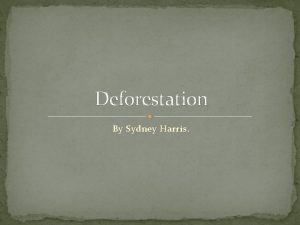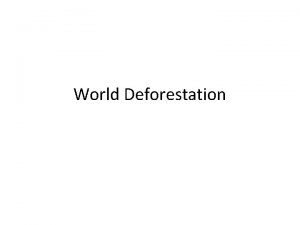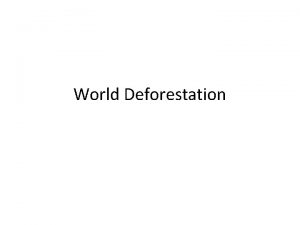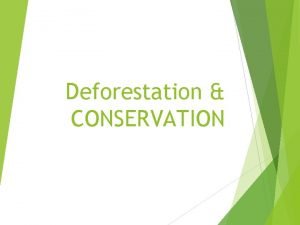Deforestation in developing countries Causes policies and positive
















- Slides: 16

Deforestation in developing countries Causes, policies and positive incentives

Contents • Introduction • Causes of deforestation • Policy approaches • Positive incentives • Conclusions

Introduction • Deforestation occurs when agents clear forested land to change its use (permanent or not? ) • Land use change is perceived to bring more benefits than preserving the forest. • FAO: “Change of land cover with depletion of tree crown cover to less than 10 percent” • Kyoto: “the direct human-induced conversion of forested land to non forested land “

Causes of deforestation • Direct (immediate or proximate): where should incentives apply? • Underlying (indirect): What incentives would work? • Agents: To whom should incentives be given? • Predisposing conditions: Is deforestation likely?

Policy approaches and positive incentives • Reducing emissions from deforestation -> reducing deforestation rates • Policies and activities outside the forest sector largely contribute to deforestation • Most examples of policies and incentives to reduce deforestation aim to support forest conservation and sustainable management. • Few examples outside the forest sector are available: policies on other sectors generally disregard their impact on forests

Policy approaches • Reducing prices and demand for agricultural and forestry products – They target public policies and economic factors. Blunt instruments, difficult to target. Effectiveness is moderate to uncertain. Rely on underlying causes. • Increasing the costs associated with deforestation – They target direct causes of deforestation. Effectiveness is moderate to low. Rely strongly on enforcement. • Addressing land-tenure – Tackle directly property rights and negative incentives to clear forest. Effectiveness is moderate to variable.

Policy approaches • Increasing the profitability of managing forests sustainably – They promote environmental investments. Rely on funding. Effectiveness is variable to high. Rely strongly on funding. • Increasing the political status of forest conservation – More a substantial policy change. Experiences in developed countries are generally positive, but this may depend on other factors.

Positive incentives • Positive incentives are economic, legal or institutional measures designed to encourage beneficial activities. • Seek a change in agent’s behavior • Most are financial in nature • Effectiveness cannot be generalized – Under specific circumstances – Effective locally, while implemented and as long as financial sustainability is ensured.

Positive incentives • Subsidies: A “financial” aid to reduce the price of a desirable good. • Transfer payments: compensations paid to individuals for an action (needs to be sufficient) – PES: A service is provided – Swaps: purchase of debt – Funds: financial resources for a specific purpose • Tax relieves (do not require funds) • Permit trading (e. g. development rights, rely on enforcement) • Enhancement of property rights (transfer responsibility, work if people depend on forest resources)

Examples • PES: Costa Rica covered more than 300, 000 ha of forests through a domestic tax on fossil fuels. Payments directly to forest owners • Swaps: Philippines: US 8 Million during 14 years for the conservation of coastal forests • Property rights: A revolving fund for biodiversity conservation that purchases land resells it to people interested in conservation • Permit trading: Tradable development rights (TDR) in the US, for example, the New Jersey Pinelands

Conclusions • Deforestation is multidimensional and causes are heterogeneous across the world: different incentives and policies • Incentives and policies should tackle direct causes while responding to underlying ones. They should consider agents. • Little is known about the effectiveness of the incentives and policies as deforestation is complex. Comparable studies are scarce.

Conclusions • Effectiveness of policies and positive incentives cannot be generalized. It depends on a wide range of factors and can vary through time as underlying factors vary. • Few examples of policies to reduce deforestation are available in sectors other than forestry • Incentives operate over agents and may address causes outside the forest sector. • There are successful examples for most types of incentives, but are case specific.

Thank you

Direct causes • Agriculture (including cattle ranching) • Logging • Infrastructure development Source: Geist and Lambin, 2002 * Cattle ranching ** Road development

Underlying causes • Policy and institutions (public, weak forest institutions, corruption and land tenure) • Economy: wealth and market structures • Technology: if promotes extensification • Culture: individual and social • Demographics

Underlying causes: Policies
 Facts about deforestaion
Facts about deforestaion Causes of deforestation in points
Causes of deforestation in points Micro climate
Micro climate Difference between developing and underdeveloped countries
Difference between developing and underdeveloped countries Harrod domar model economics
Harrod domar model economics Comparative education in developing countries
Comparative education in developing countries Poor wesley 015
Poor wesley 015 Application of harrod-domar model in developing countries
Application of harrod-domar model in developing countries Esrc wellbeing in developing countries
Esrc wellbeing in developing countries Calvin miller coltivare
Calvin miller coltivare Deforestation
Deforestation Overpopulation define
Overpopulation define Ultimate cause of behavior
Ultimate cause of behavior Proximate and ultimate causes of behaviour
Proximate and ultimate causes of behaviour Antiglobulin meaning
Antiglobulin meaning Romberg test positive causes
Romberg test positive causes Positive romberg test causes
Positive romberg test causes
